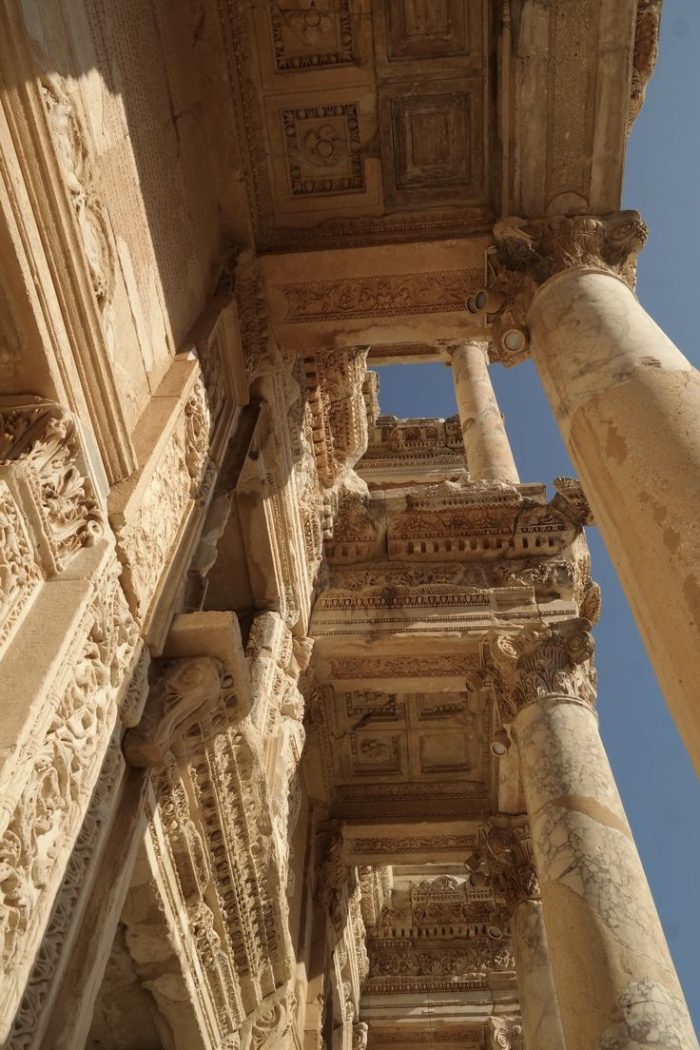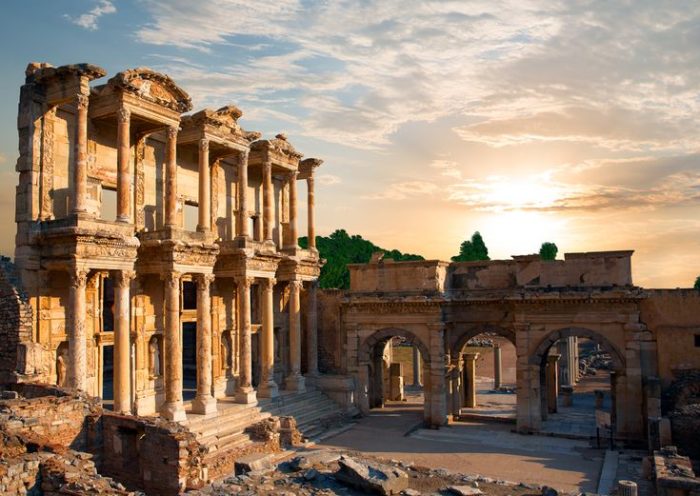
Located in the heart of the Ancient City of Ephesus, the Celsus Library is not only one of the most significant cultural centers of the ancient world but also a pinnacle of architectural elegance and engineering. Built between AD 114 and 117 in honor of the Roman Emperor Celsus, this library has managed to endure through the ages as an extraordinary structure both in terms of engineering and aesthetic beauty. However, the magnificence and grace of the Celsus Library are defined not only by its architectural design but also by the materials used. Notably, the “Afyon Vişnesi” (Afyon Violet) marble employed in its exterior façade has not only elevated the aesthetic value of the library but has also ensured its enduring harmony and structural integrity over time. As one of the ancient world’s most important libraries, the building reflects the most advanced artistic and architectural ideals of its era.
The main façade, supported by four grand marble columns, was enriched with detailed reliefs and statues. The two-story structure stood 17 meters high and 21 meters wide. The interior consisted of three sections and housed between 12,000 and 15,000 parchment and papyrus scrolls. To protect the valuable documents from humidity and dampness, a corridor (podium) separated the internal and external walls surrounding the reading room. On the lower level of the library, Emperor Celsus’s tomb was placed. It was a rare occurrence in the ancient world to place a tomb within a public building.
Afyon Vişnesi (Afyon Violet) Marble: A Key Element of Aesthetic and Functionality
Afyon Vişnesi marble, extracted from quarries in the Afyonkarahisar province of Turkey, is renowned for its striking color and texture. Known for its deep red and pink hues, this marble was one of the most prized stones used in antiquity. The use of this particular marble in the Celsus Library goes beyond being a mere structural material; it is a significant component that reflects the architects’ aesthetic vision.
The marble’s application is most evident in the architectural details of the library’s façade, including the sculptural niches, columns, and door thresholds. As the Celsus Library embodies the aesthetic sensibilities of its time, the durability and workability of the marble have allowed it to maintain its elegance for thousands of years. The warm and refined tone of Afyon Vişnesi (Afyon Violet) marble blends seamlessly with the structural integrity of the building, ensuring that the library transcends its role as a mere repository of knowledge to become an artistic masterpiece in its own right.
A Balance Between Aesthetics and Functionality
During the era in which the Celsus Library was constructed, the Roman Empire placed as much importance on the functionality and durability of a building as on its aesthetic qualities. The marble used in the building’s exterior was not only a visual element but also a material that contributed to the structure’s strength and longevity. Known for its resilience to harsh climatic conditions, Afyon Vişnesi (Afyon Violet) marble played a pivotal role in the library’s preservation over the centuries.
The natural texture of the marble added a subtle depth to the surfaces of the structure, while its workability allowed sculptors to create intricate figures and details. The marble statues, column capitals, and niches within the Celsus Library are regarded as reflections of the high artistic standards of the Roman period.
Enduring Beauty: From Antiquity to Modernity
Today, those who admire the grandeur of the Celsus Library also recognize the exceptional quality and meticulous selection of the materials used in its construction. Stones like Afyon Vişnesi (Afyon Violet) marble, which withstand the test of time, serve as a refined bridge between ancient and modern architecture. Contemporary architects have begun to incorporate the textures and aesthetic qualities of this marble in modern buildings, but just as in the Celsus Library, its craftsmanship and application not only serve a functional purpose but also impart cultural and artistic significance to the structure.
The mastery with which Afyon Vişnesi (Afyon Violet) marble was carved by ancient stoneworkers, combined with the technical knowledge of the time, provided the Celsus Library with visual elegance and ensured the longevity of the building. This is an exemplary case of the seamless integration of a material’s physical properties with its architectural function. The Celsus Library is a perfect example of how stone and marble were used not merely as building materials but as symbols of culture, art, and wisdom. The use of Afyon Vişnesi (Afyon Violet) marble in the construction of the library reflects the artistic and aesthetic ideals of the time, while also underscoring the importance of stone in the creation of human-made structures.
The Celsus Library continues to remind each visitor of the timeless significance and depth of this monumental building. The library not only draws attention with its imposing architecture but also with the sculptures adorning its façade. The replica statues on the façade represent the Four Virtues: Sophia (Wisdom, Reason), Arete (Virtue, Character), Episteme (Knowledge, Science), and Ennoia (Fate, Judgment). The original statues are displayed in the Ephesus Museum in Vienna.
The Celsus Library, a rare example of a structure that has survived through time with the intricate use of stone and stone craftsmanship, remains a must-see monument of the ancient world.




